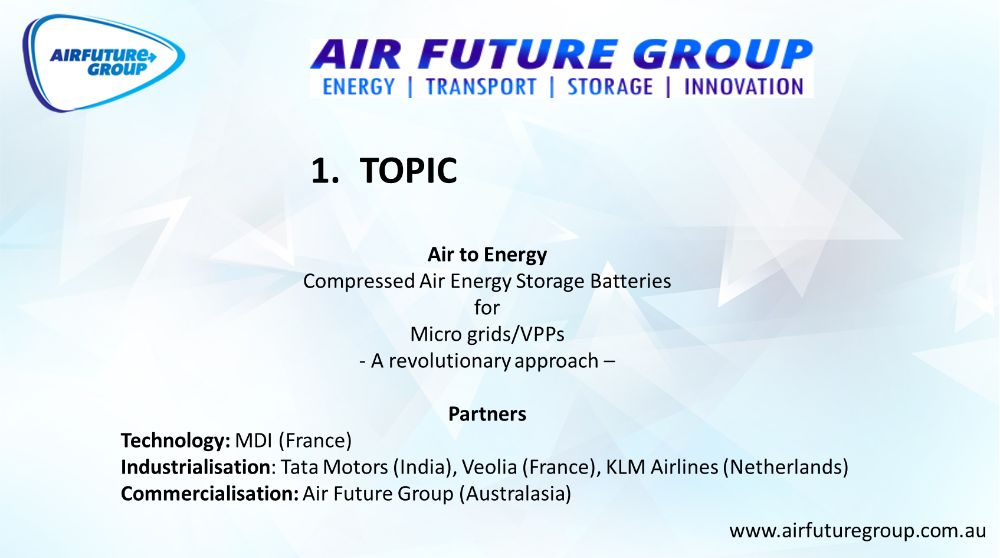
LAUNCHING MDI’s PRODUCTS & AFG’s COMMERCIALISATION
A great opportunity to launch to a sophisticated and professional audience.
We also chaired the Roundtable Discussion: Smart Energy Policies and Programs:
Are Governments’ incentives sufficient and appropriate to drive consumer uptake?
TOPIC AFG PRESENTATION
Air to Energy
Compressed Air Energy Storage Batteries for Micro grids/VPPs. A revolutionary approach.
THE CONFERENCE
THE VIRTUAL POWER PLANTS NEW ENERGY STORAGE AND RENEWABLE ENERGY INNOVATIONS
GLOBAL SUMMIT 2019
(Capitalising on the rise of the new green grid and digital utilities) 14th-15th November 2019
LEADING ORGANISATIONS PRESENTING
*Minister for Energy, Environment & Climate Change *Australian Energy Market Commission, *Clean Energy Council,
*CSIRO *ABB *Monash University *Horizon Power *RMIT *Woodside, *Government of South Australia *Tesla *Mayor Byron Shire *Power Ledger *Synergy *Australian National University * Australian Energy Market Operator *University of Melbourne, *Australian Energy Market Commission, *Silverpond (CitiPower) *Reposit Power

READER INTRODUCTION
These words were composed post the presentation, for broader circulation AFG was introduced, as was MDI, explaining that MDI were the patented research and developers of the technology, and progressing partnerships or joint ventures with third parties, for example Tata Motors, Veolia, and KLM Airlines. MDI’s industrialisation is via micro distributed manufacture under geographic and product licences. AFG has licence options for Australasian commercialisation.
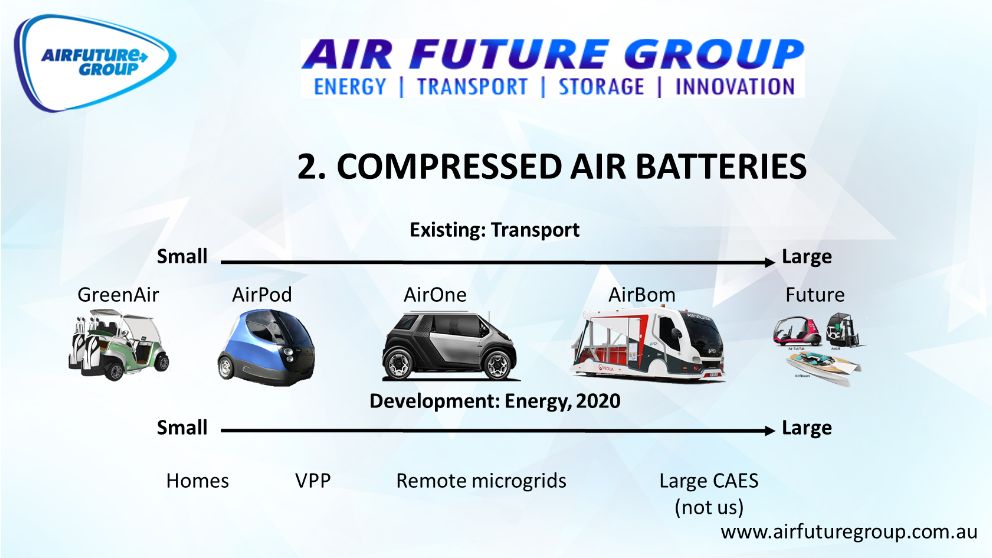
COMPRESSED AIR BATTERIES
* The core MDI technology was introduced as a system that stores energy to subsequently generate power or electricity
That generation can be used to power vehicles, or to provide distributed electricity.
* Furthermore MDI’s development approach is always an holistic one where the best end goal is achieved by taking into
account all elements at a system and manufacture level, driven by customers.
* The first focus has been on vehicles, utilising composite materials and integrated functions for less weight, along with
an optional low pollution external burner for efficient dual fuel use, plus distributed manufacture for lower cost and pollution.
* The five vehicles seen are the first range, with most transport options planned for the future.
* Now a core focus ahead is energy storage, including homes, VPPs, microgrids, and remote.
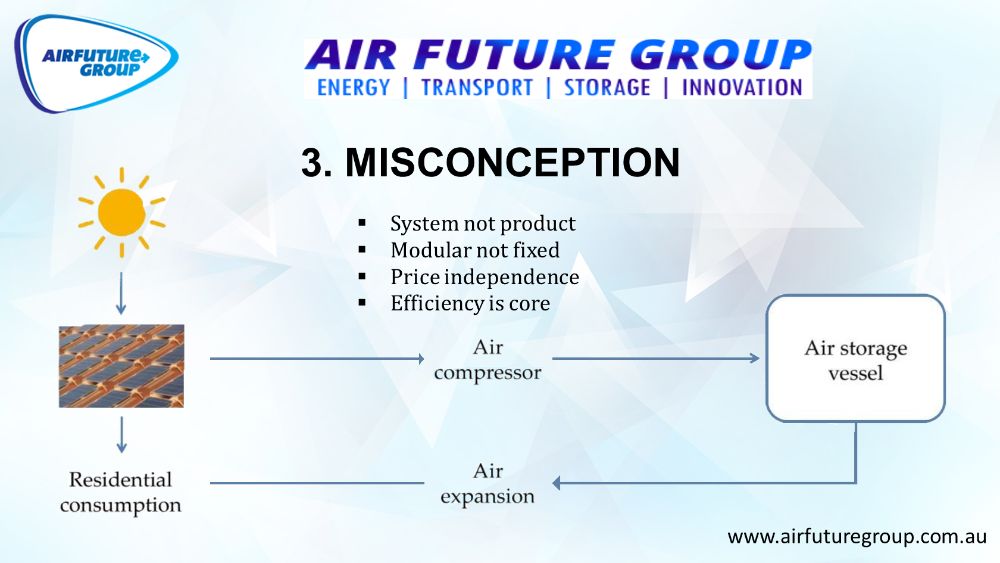
MISCONCEPTION
* A common misconception is that compressed air storage is all about the tank, whereas the key challenge is the expansion
and the overall system. And systems are both the compressed air storage system and the home or VPP overall system.
Hence the question “how many kilowatt hours (kWh) in a tank” is incomplete. Similarly amongst industry professionals questions
will quickly arise as to round trip efficiency and energy density. And these need to be addressed, however……
* The focus needs to be on the system, not the component. For example gasoline is high energy density, but internal
combustion engines have a low round trip efficiency. Hence the design is not just on the components but on the
thermodynamics and mechanics of the system.
* With modular components there is a higher degree of flexibility to achieve optimum efficiency and price for the consumer,
and this will differ for homes versus VPP’s due to scale benefits.
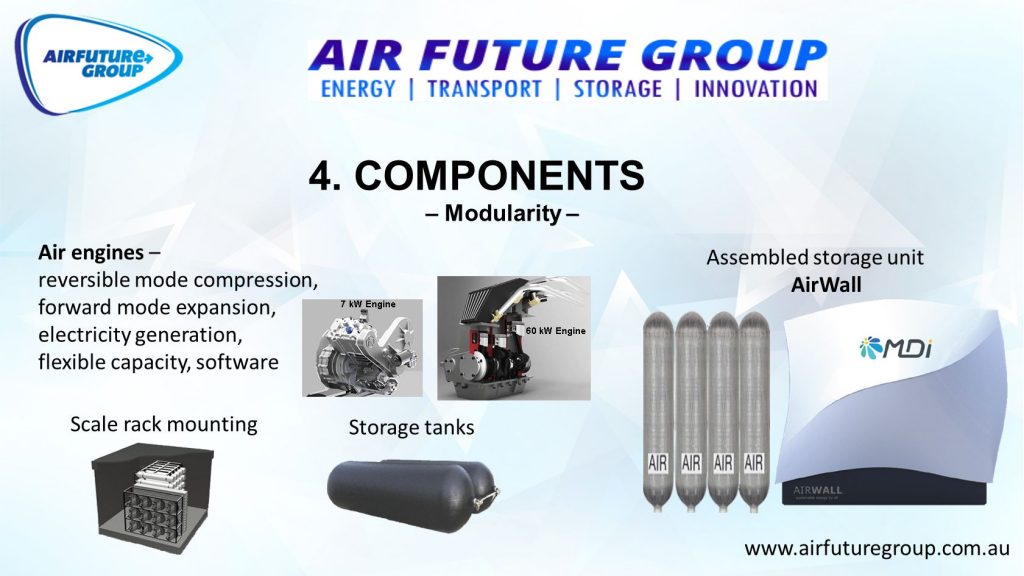
COMPONENTS
* The MDI storage system consists of a generation source such as solar, a small motor to drive the engine in reverse to
compress air into the tanks, and the air engine driven in forward mode to drive the alternator to generate the electricity.
* At the core is the compressed air engine, either the 7 kW, 2 cylinder, 430 cc, 20 kg engine, or in the pipeline the 60 kW,
3 cylinder, 1000 cc, 35 kg engine. Via control of the revolutions per minute the engine kW can be varied.
* The home or business energy unit is the MDI AirWall, packaging the components including the tanks. There are two levels
of software; that controlling the engine and that relating to the system in which it is operating. The components can be
combined modularity for optimisation, and maintenance is low with no heat.
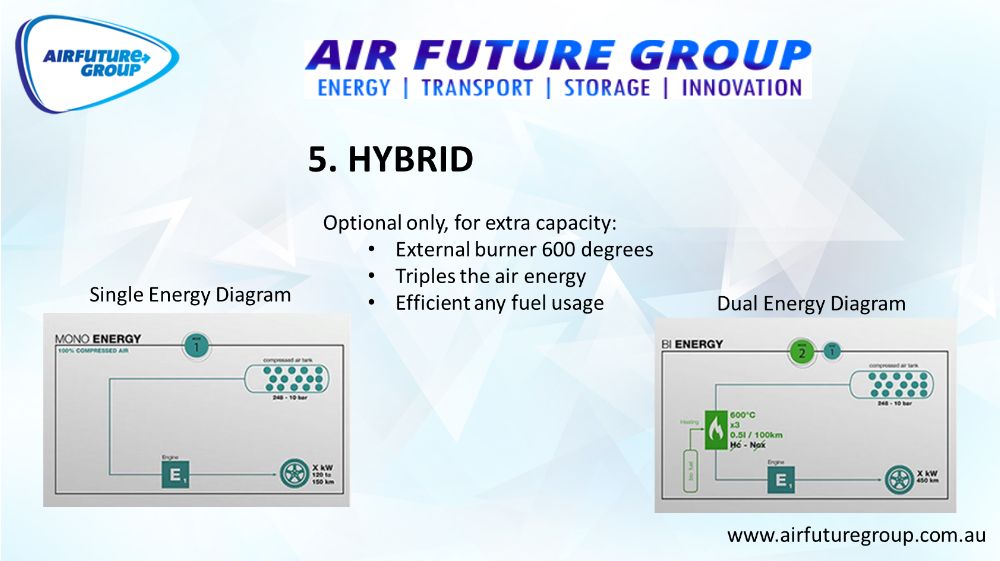
HYBRID
* The MDI storage and energy system has an optional additional mode of operation we refer to as hybrid. During the
evolution in both energy and transport industries to renewable energy and clean climate, there will be numerous fuels used,
some efficiently, some inefficiently, and internal combustion is one of the worst, both for inefficiency and pollution.
* A significant hurdle for the renewable energy sources is range (e g vehicles) or energy (e g kWh). MDI have developed an
optional external burner at low 600 degrees centigrade to heat the air entering the engine (as compared to the 2,000 degree
internal combustion explosions).
* This option increases the air volume and hence the range/energy by a factor of 3x. Any form of fuel (e.g. biofuel) can be
used, pollution is minimised, and fuel efficiency is far greater. Unlike traditional hybrid having two systems MDI hybrid mode
is the same system and very efficient.

HOME STORAGE
* The home energy system diagram using compressed air storage and electricity generation shows the various functions from
solar to inverter to the AirWall system functions ( tanks, expansion, alternator) to the home. The AirWall will include the
engine management software and the storage system software.
* AFG seeks to work with other parties to integrate into modern smart meters and behind the meter demand management
systems to optimise both the customer experience and the main grid management desires, regulations, reporting, and
controls. These relate to firming and frequency control and peaking for grid management.
* Each customer case may be unique, and the AirWall product is able to be tailored at the factory or at the site, including
subsequent on site upgrade enabled by flexible components.
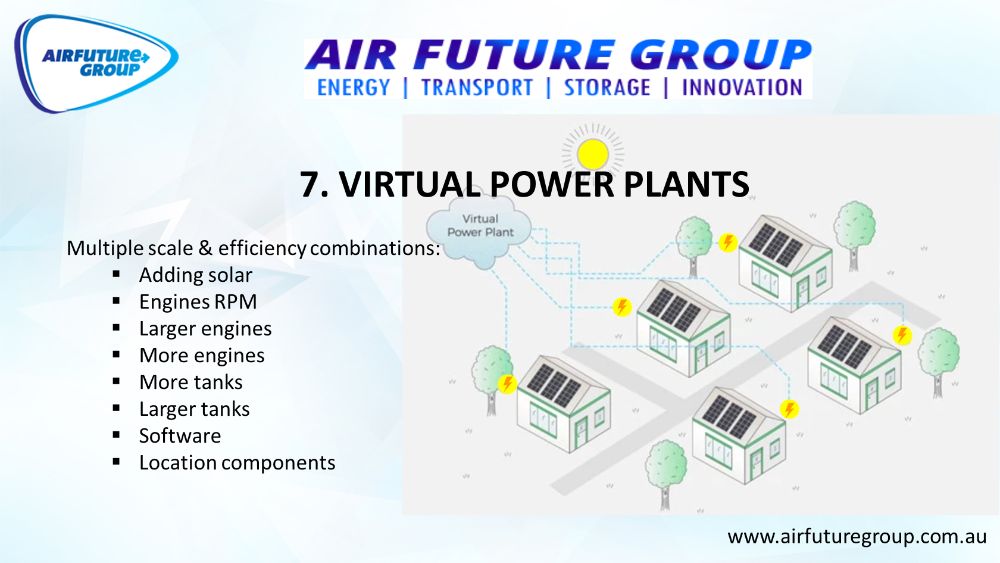
VIRTUAL POWER PLANTS
* A key to energy storage is the ability to scale. Scale does not just mean increasing capacity, which can always be done by
duplicating what already exists or increasing size (e g racking batteries). Economical scaling is where adding more capacity
(e g kW) results in a decreasing marginal cost of extra energy produced, so as the system increases in size the added
energy produced become progressively cheaper.
* This is very relevant for VPP (community inter-connected homes). The AirWall due to its system modularity has significant
scaling benefits over other storage providers, and scale can be provided via the seven means shown, not just by adding
another unit (e g by adding tanks).
* When VPP’s start to adopt the many new smart technologies (e g blockchain, demand sharing), assets can be pooled and
users and assets managed dynamically. Tanks could be placed underground, engines pooled, and solar where space and
transmission suit.
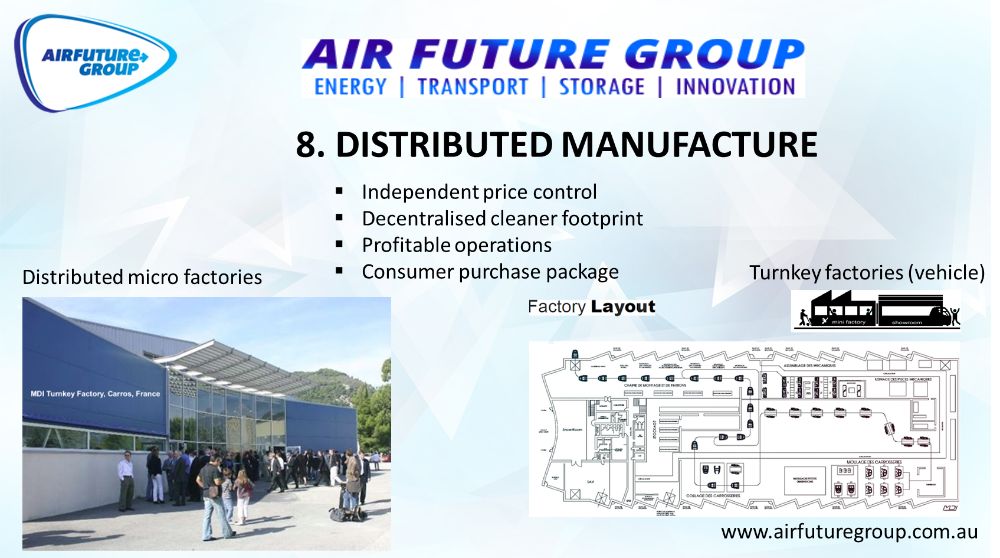
DISTRIBUTED MANUFACTURE
* The nature of both the compressed air vehicles and the compressed air storage and generation is such that manufacture
can be ideally performed distributively in micro factories. These have many benefits globally it is much cleaner as there are
not the shipping, distribution and warehousing costs. These additional elements also add a significant margin to the cost.
Furthermore control now sits centrally rather than in the region. Distributed manufacture significantly aids the local economy.
* Factories are turnkey, meaning that their construction, equipment, operation and processes are all pre-designed and the
same. This makes the establishment of the factories cheaper and straightforward. Factories are strongly profitable, whilst
still achieving affordable pricing
* A major benefit is local price control, as energy storage systems are to some extent flexible and costs are factory local.
Hence competitor price benefits can be controlled sustainably.
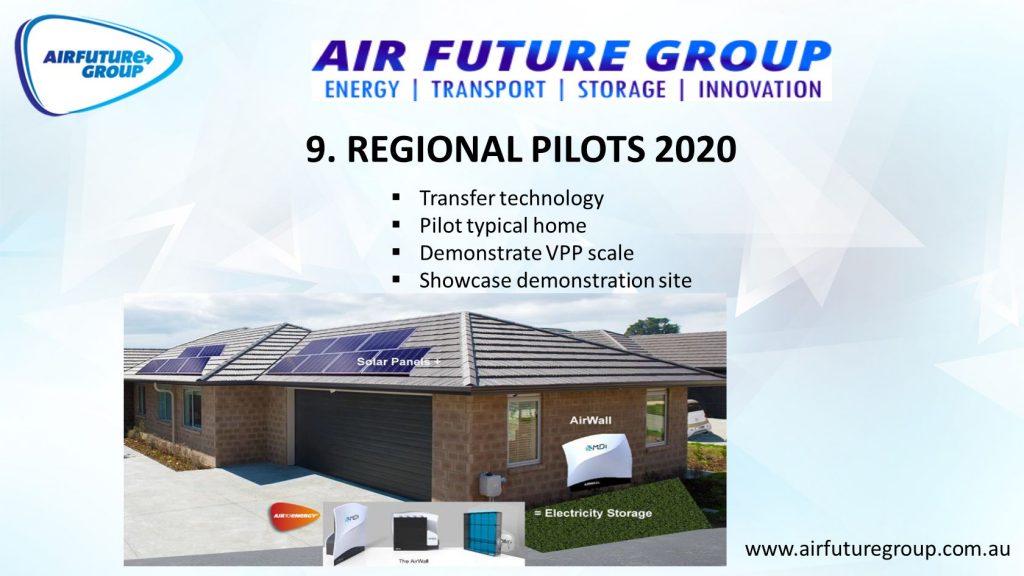
REGIONAL PILOTS 2020
* It has taken some decades for MDI along with inputs from their partners like Tata and Veolia to reach the level of design
achieving the efficiencies and affordabity for the new consumer experiences. The intention is that these positive
experiences create a level of take-up in both transport and energy storage not yet being achieved with existing technologies
and subsidies.
* And in the meantime providing the benefits and idependence of local manufacture It’s well accepted that the storage
market is already massive.
* AFG will be working with MDI throughout 2020 to enable the technology to be transferred to Australasia a potential global showcase for renewable energy with already 50% of all energy in Australia now from renewables and rooftop solar increasing rapidly.
* Currently storage uptake is lagging, due largely to affordability, and lagging so much that significant subsidies are not
sufficient. MDI pilots seek to provide a sustainable solution.
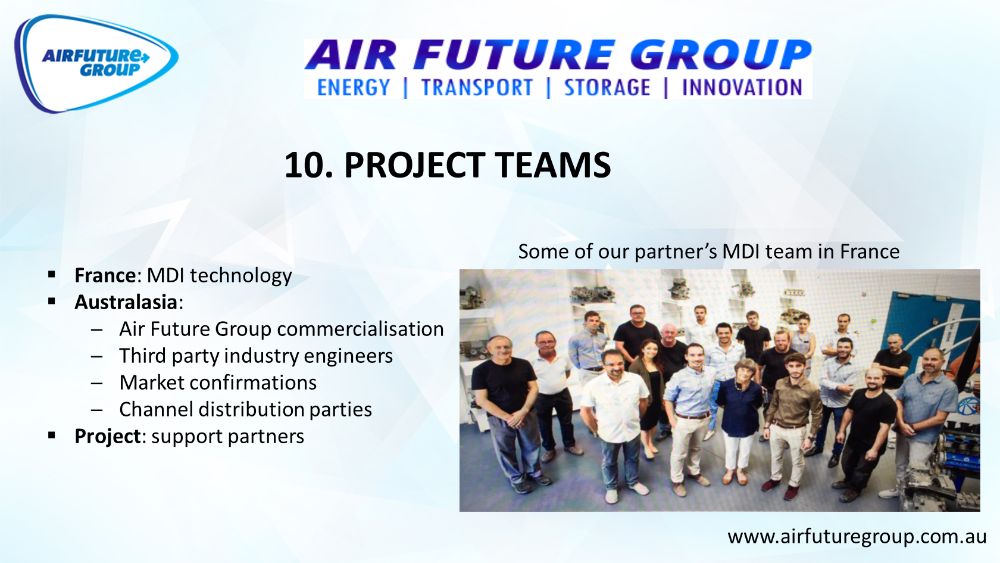
PROJECT TEAMS
* The conference was very well attended, and we saw it to some extent as our public launch.
* There was huge interest at the conference, and the potential for pilot partnerships spanning universities to government to
retailers and technology providers.
* The process of technology transfer via pilots, demonstration and showcase was explained. A local market team to liaise with
MDI Air Lab.
* However unilaterally those parties wanted to first learn more. Their questions were not many, but very fundamental. These
few we will list in bullet form and be addressing with MDI.

